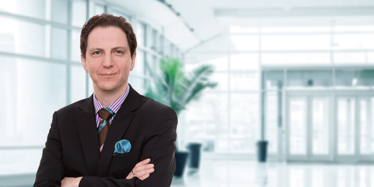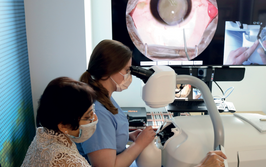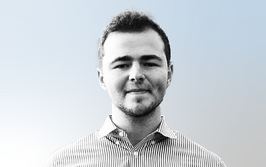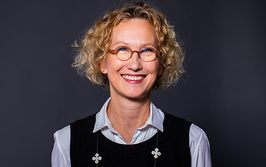Mr. SMILE
Sitting Down With... Walter Sekundo, Chairman of the Department of Ophthalmology, Philipps University of Marburg, Germany

What led you to ophthalmology?
I always wanted to be a general surgeon, but because of a spinal injury I suffered when I was 13 years old, I realized in medical school that I wouldn’t be able to stand at an operating table for hours and hours in the long term. How I actually ended up in ophthalmology was quite coincidental. I partially studied in the US, starting with internal medicine at Tulane University, which I found too boring because I like to do something with my hands. So then I did OB-GYN, but I only enjoyed the obstetric parts. I asked the secretary if there were any other clerkships, and it turned out that nobody had applied for an ophthalmology clerkship. A friend of mine recommended Louisiana State University – at the time, Herbert Kaufman was Chairman and Marguerite McDonald was an Associate Professor. Later, my first post-graduate fellowship at the Tennent’s Institute of Ophthalmology with Bill Lee and Colin Kirkness in Glasgow, UK, got me specifically interested in cornea and anterior segment.
And refractive surgery?
I started doing intraocular surgery in my second year of residency – which is quite early. But when I went to the University of Marburg as a consultant and started refractive surgery, I felt that I needed to catch up a bit. So I applied for a refractive and corneal surgery fellowship at Moorfields with Julian Stevens. I learnt a lot from Julian, and when I returned to Germany, I moved on very quickly and also obtained a PhD.
What’s the story behind developing SMILE?
I was approached by Zeiss because of my academic interest in refractive surgery. After initial animal studies, Marcus Blum and I moved into patients. At that stage, it wasn’t the familiar laser setup available today – it was a very simple box. The first procedure we performed was FLEx – femtosecond lenticule extraction with a flap. We presented results from the first 10 eyes at the 2006 AAO meeting in Las Vegas – and people didn’t believe us. SMILE was a further development of the FLEx procedure. We performed many studies involving the flap and incision locations, and performed the procedure in around 200 eyes in one year. Zeiss were keen to have more patients treated – and more data – so they brought Rupal Shah on board. Within three months she had performed the surgery on around 500 eyes. Now, there have been over one million registered procedures performed worldwide. We carried on researching to get to the stage we are the moment, and we are still doing a great deal of research, including biomechanical experimental work and surgical prospective studies, among those hyperopic SMILE. And that’s how I became “Mr. SMILE”.
Were there any interesting challenges in SMILE development?
I began studies with cadaver pig eyes, but when I moved to rabbits it didn’t work well. As a trained eye pathologist, I studied their corneas and realized that the rabbit cornea had an entirely different structure compared with human cornea. So we decided to use piglets – but they grow incredibly fast, becoming huge by three months follow-up. Because of the issues with my back, Zeiss actually hired two strong veterinarian nurses to carry pigs for experiments! They also hired a veterinarian anesthesiologist so we could examine them. In the end, it worked very well in pigs...
What do you think the refractive surgery market will look like in 10 years’ time?
I really want to see a few more companies come to the market with SMILE, because this will drive the market forwards. There is no question that we need better lasers for it to be more accepted within the ophthalmic community. I do believe that SMILE will grow, but I do not believe that it will replace femto-LASIK entirely. I think in the long-term we will have SMILE as a standard procedure, with femto-LASIK and PRK as additional procedures for certain indications. But at the end of the day, the armamentarium we have becomes larger. Just like IOLs, we try to select the best possible procedure for the patient. And this is what makes refractive surgery so different from the way it was performed in the early 90s. In those days, we were looking at just reducing diopters. Now, we also want to deliver a high quality of vision.
I also think IOLs will improve. When you look at the development of cataract surgery, the major developments are better lenses and better optics. In 10 years’ time, I hope we’ll see a real accommodating IOL – this would be a significant breakthrough. Once we have a real accommodating IOL, it will change the entire refractive surgery market; we’ll be able to approach emmetropia and presbyopia. And we might move to work more inside of the eye rather than performing surgery on the surface.
Any advice for the younger Walter Sekundo?
Simply to do everything the way I did it – I have no regrets. I was lucky to be in the right place at the right time. I would also say that it is important to benefit from what you do and to be able to carry on professionally. When people at our institute obtain PhDs and professorships, I usually tell them to remember that they didn’t achieve these things to treat only private patients – there are other obligations, such as passing on the knowledge acquired over the years to the next generation and actively contributing to the progress of our profession by high quality research.
Walter Sekundo has been Chairman of the Department of Ophthalmology at Philips University of Marburg, Germany, since December 2008. In 2008, Sekundo and his colleague Marcus Blum were awarded first prize by the American Society of Cataract and Refractive Surgeons for their work in the field of refractive surgery. In 2010, both Sekundo and Blum were awarded the Leonhard Klein Prize for their work on FLEx. Sekundo has authored over 100 publications on refractive surgery, and has edited the textbook “Small Incision Lenticule Extraction (SMILE): Principles, Techniques, Complication Management and Future Concepts”.
Walter Sekundo has been Chairman of the Department of Ophthalmology at Philips University of Marburg, Germany, since December 2008. In 2008, Sekundo and his colleague Marcus Blum were awarded first prize by the American Society of Cataract and Refractive Surgeons for their work in the field of refractive surgery. In 2010, both Sekundo and Blum were awarded the Leonhard Klein Prize for their work on FLEx. Sekundo has authored over 100 publications on refractive surgery, and has edited the textbook “Small Incision Lenticule Extraction (SMILE): Principles, Techniques, Complication Management and Future Concepts”.













